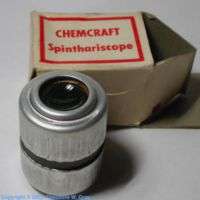Spinthariscope

A spinthariscope is a device for observing individual nuclear disintegrations caused by the interaction of ionizing radiation with a phosphor (see radioluminescence) or scintillator.
Invention
The spinthariscope was invented by William Crookes in 1903.[1][2] While observing the apparently uniform fluorescence on a zinc sulfide screen created by the radioactive emissions (mostly alpha radiation) of a sample of radium bromide, he spilled some of the sample, and, owing to its extreme rarity and cost, he was eager to find and recover it.[3] Upon inspecting the zinc sulfide screen under a microscope, he noticed separate flashes of light created by individual alpha particle collisions with the screen. Crookes took his discovery a step further and invented a device specifically intended to view these scintillations. It consisted of a small screen coated with zinc sulfide affixed to the end of a tube, with a tiny amount of radium salt suspended a short distance from the screen and a lens on the other end of the tube for viewing the screen. Crookes named his device from Greek σπινθήρ (spinth´ēr) "spark".
Toy spinthariscopes
Spinthariscopes were quickly replaced with more accurate and quantitative devices for measuring radiation in scientific experiments, but enjoyed a modest revival in the mid 20th century as children's educational toys.[4] In 1947, Kix cereal offered a Lone Ranger atomic bomb ring in exchange for a box top and 0.15 USD that contained a small one.[5][6] Spinthariscopes can still be bought today as instructional novelties, but they now use americium or thorium.
References
- ↑ Crookes, W. Certain Properties of the Emanations of Radium. Chemical News; Vol. 87:241; 1903.
- ↑ Frame, Paul W. "The Crookes Spinthariscope". Oak Ridge Associated Universities. Retrieved 2 May 2013.
- ↑ Alfred Romer (1960). The Restless Atom: The Awakening of Nuclear Physics. Anchor Books. Retrieved 2 May 2013.
- ↑ Bonnier Corporation (June 2007). Popular Science. Bonnier Corporation. pp. 86–. ISSN 0161-7370. Retrieved 2 May 2013.
- ↑ Reif, Rita. ARTS/ARTIFACTS; Trivia Long Ago, Serious Treasures Now. The New York Times. 11 June 1995.
- ↑ Lone Ranger Atom Bomb Ring Spinthariscope (1947 – early 1950s)
External links
- Modern spinthariscope
- Elements of electricity: a practical discussion of the fundamental laws and ... by Robert Andrews Millikan, Edwin Sherwood Bishop, American Technical Society